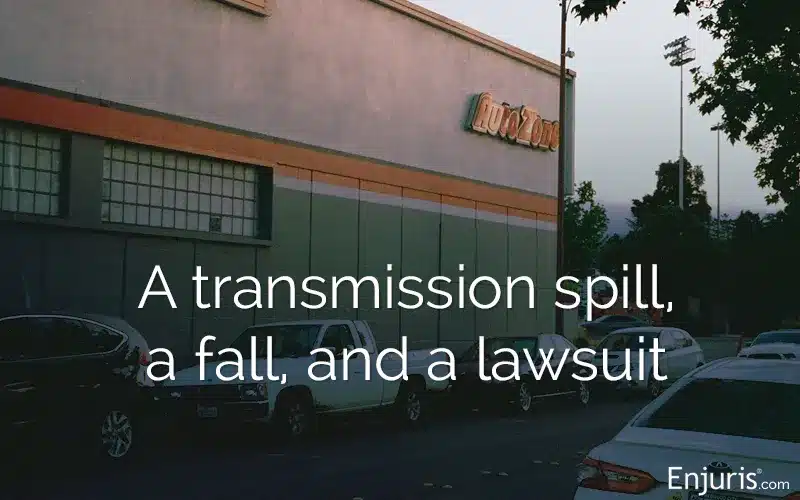A common misconception about slip-and-fall accidents is that if someone falls while they’re on another's property, they automatically have the right to sue.
In reality, a person who sues another in a court of law is required to prove 4 parts of liability in a trip and fall or slip and fall case.
Typically, all of these factors must be proven, for the lawsuit to result in a successful outcome.
1. Duty
Essentially, duty is the obligation of the property owner or occupier to keep the property and premises safe from dangerous conditions. Property owners have a responsibility to prevent and remedy conditions that pose a foreseeable risk of injury.
Whether or not the occupier or owner had a duty to protect the property generally depends on who had control over the premises at the time of the accident. The case cannot be won unless duty is proven.
2. Notice
Notice is another critical factor in a slip, trip and fall case. Generally, to establish fault, it must be shown that a property owner, manager or another person with a duty of care, knew or should have known of the existence of the dangerous condition that caused injury and acted unreasonably in their failure to repair, warn, barricade, detour or otherwise prevent the injury.
The 2 types of notice are actual and constructive.
Actual notice
Actual notice is when the party with the duty of care actually knew a dangerous condition existed. A supermarket manager that’s told of a spill in the beverage aisle but decides he’ll wait until his workers finish unloading a truck before asking them to post a “wet floor” sign and mop up the spill would be an example.
Prior written notice is potentially a powerful form of actual notice. An example of strong actual notice is if a tenant sends a certified mail notice to a landlord that there’s a chronic leak every time it rains from the ceiling over the steps in a common area of a building that has been ignored and needs to be repaired immediately. If someone is injured on those steps as a result of the leak, there’s a strong case for slip and fault negligence.
Constructive notice
Constructive notice refers to cases where the circumstances were such that, in the exercise of due care, the party with a duty to maintain the property should have known of the dangerous condition.
Going back to the rain leak example above, if the condition existed over a significant period of time — or recurred whenever it rained (especially if it left damage or discoloration in the ceiling where the rainwater intruded) — the landlord, super, or managing agent should have been aware of the danger just by performing some reasonable level of inspection.
If it can be proven that the defendant unreasonably failed to abide by industry standards, then it's possible they can be held responsible for such improper premises management since it caused an accident.
Commonly, the defendant will assert that they weren’t aware of the danger, as they had no notice — neither actual or constructive. This is one of the many scenarios where having a slip, trip or fall lawyer can make the difference between success and failure in your premises liability case.
If property owners and managers (of stores, apartment complexes, office buildings, malls, etc.) don't conduct regular checks to see if there are any unnoticed spills or tripping hazards, someone could get hurt. Failing to conduct a routine inspection isn’t an excuse for not knowing about a potential danger.
Also, if the property owner or property manager caused or created the condition that caused an injury, it’s assumed they had notice of the condition
3. Hazardous condition
Although it's apparent to the person who got hurt that a hazardous condition existed when the injury took place, it still needs to be proven to a judge or in court.
A condition is considered “hazardous” if it poses a foreseeable risk of harm (for example, steps that collect rainwater from the leaky ceiling). There are an infinite number of such potential hazards. Broken floor tiles, uneven walkway paving stones, icy sidewalks, building entrances with no mat that become wet from snow and rain — these are just a few examples of potentially hazardous conditions.
As discussed in the “Notice” section above, it must be proven that the defendant was aware or should have been aware of the current danger at the property. The property owner or occupant had the responsibility to remedy the danger but they didn't, which resulted in an unreasonable risk that caused an injury.
Another associated factor that often must be proven is that the property was being used correctly, in a regular manner.
4. Causation
Finally, there needs to be ample evidence showing that the hazard was responsible for the injuries, such as having a diagnosis for the injury that matches the fall scenario.
If the defense can convince the jury or judge to believe that the harm didn’t occur because of the accident, the injury alone won't be enough evidence to win the liability litigation case.
Once again, this is where an experienced, dedicated accident injury lawyer can make all the difference. By gathering all the relevant evidence and presenting it in a compelling manner, the injured person’s lawyer will demonstrate how the dangerous condition was the direct cause of the injuries sustained.
Conclusion
In summary, if duty, notice, hazardous condition, and causation can be proven, then it's likely that your slip and fall lawsuit will be successful.
Florida Woman Wins $1M in AutoZone Slip and Fall Lawsuit
A woman slipped on transmission fluid in an Ocala AutoZone parking lot; now she’s $1 million richer.



Paternoster Law Group says
Everyone will find this blog very handy especially since we never know what can happen all of a sudden. Thank you for sharing this article. I enjoyed reading very informative blogs on your page. Thanks!
Ian Pisarcik says
Thank you for the comment!